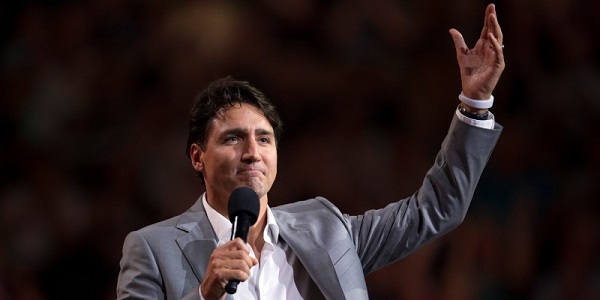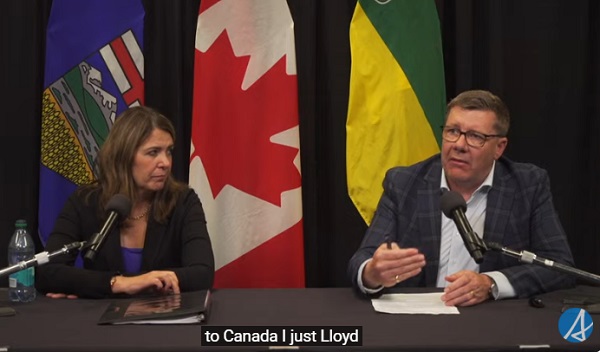Energy
Federal government’s ’carbon-free’ electricity target far-fetched

From the Fraser Institute
By Elmira Aliakbari and Jock Finlayson and Tegan Hill
A recent report by the Canada West Foundation, which analyzed 25 major projects that entered the federal government’s review process between 2019 and 2023, found that all 25 were still stuck in the early stages (phase 1 or 2) of the four-phase process.
Did you know that the Trudeau government wants to “decarbonize” Canada’s electricity generation by 2035? That is, make carbon-free sources (e.g. wind, hydro and solar) the sole power source for electricity generation in Canada.
Is this possible? No.
As of 2023 (the latest year of available data), nearly 81 per cent of Canada’s electricity came from carbon-free sources. To replace the remaining 19 per cent that relies on fossil fuels over the next 10 years, Canada would need to add a massive amount of generation capacity.
Specifically, we would need approximately 23 new large hydroelectric dams similar in size to British Columbia’s Site C project. Of course, due to regulatory hurdles and approval processes, it takes a long time to plan and construct major electricity generation facilities in Canada. The Site C project took approximately 43 years (from initial feasibility and planning studies in 1971) to secure environmental certification in 2014. Construction finally began on the Peace River in northern B.C. in 2015 with completion expected in 2025—at a cost of at least $16 billion.
Alternatively, we would need more than two large scale nuclear power plants the size of Ontario’s Bruce Power, which took nearly two decades to complete with billions of dollars in cost overruns.
Or we’d need approximately 11,000 new large wind turbines, which would require clearing approximately 7,302 square kilometres of land (that’s larger than Prince Edward Island and nearly nine times larger than Calgary). The new turbines would also require substantial investments in backup power systems due to the wind’s intermittency, which of course would further drive-up costs across the electricity system.
And remember, as Canada’s population grows, electricity demand will increase significantly. The infrastructure mentioned above would only decarbonize Canada’s current electricity needs, without accounting for the additional capacity required to meet future demand.
And yet, despite its aggressive plan to decarbonize, the Trudeau government in 2019 introduced the Impact Assessment Act (IAA)—also known as Bill C-69—which added layers of uncertainty and complexity to project reviews. A recent report by the Canada West Foundation, which analyzed 25 major projects that entered the federal government’s review process between 2019 and 2023, found that all 25 were still stuck in the early stages (phase 1 or 2) of the four-phase process.
In other words, while Ottawa’s electricity decarbonization plan requires an unprecedented wave of new energy projects, the government’s own regulatory regime will make it harder for new projects to get off the ground.
The total costs of the federal government’s plan are incalculable. But we do know who will get hurt the most. Three provinces—Alberta, Saskatchewan and Nova Scotia—depend most heavily on fossil fuels to generate electricity. In Alberta, approximately 85 per cent of electricity comes from fossil fuels, mainly natural gas, while carbon-free sources generate only 15 per cent. Clearly, Alberta and these other provinces will face the greatest challenges—and heaviest burdens—in decarbonizing their grids.
In light of the basic realities of project construction timelines, regulatory hurdles and the massive financial investment required, the Trudeau government’s target to achieve 100 per cent fossil fuel-free electricity by 2035 is far-fetched. But the costs of pursuing that target will be very real and felt by all Canadians, with the size of the costs depending largely on where you live.
Authors:
Economy
Ottawa’s muddy energy policy leaves more questions than answers

From the Fraser Institute
Based on the recent throne speech (delivered by a King, no less) and subsequent periodic statements from Prime Minister Carney, the new federal government seems stuck in an ambiguous and ill-defined state of energy policy, leaving much open to question.
After meeting with the premiers earlier this month, the prime minister talked about “decarbonized barrels” of oil, which didn’t clarify matters much. We also have a stated goal of making Canada the world’s “leading energy superpower” in both clean and conventional energy. If “conventional energy” includes oil and gas (although we’re not sure), this could represent a reversal of the Trudeau government’s plan to phase-out fossil fuel use in Canada over the next few decades. Of course, if it only refers to hydro and nuclear (also forms of conventional energy) it might not.
According to the throne speech, the Carney government will work “closely with provinces, territories, and Indigenous Peoples to identify and catalyse projects of national significance. Projects that will connect Canada, that will deepen Canada’s ties with the world, and that will create high-paying jobs for generations.” That could mean more oil and gas pipelines, but then again, it might not—it might only refer to power transmission infrastructure for wind and solar power. Again, the government hasn’t been specific.
The throne speech was a bit more specific on the topic of regulatory reform and the federal impact assessment process for energy projects. Per the speech, a new “Major Federal Project Office” will ensure the time needed to approve projects will be reduced from the currently statutory limit of five years to two. Also, the government will strike cooperation agreements with interested provinces and territories within six months to establish a review standard of “one project, one review.” All of this, of course, is to take place while “upholding Canada’s world-leading environmental standards and its constitutional obligations to Indigenous Peoples.” However, what types of projects are likely to be approved is not discussed. Could be oil and gas, could be only wind and solar.
Potentially good stuff, but ill-defined, and without reference to the hard roadblocks the Trudeau government erected over the last decade that might thwart this vision.
For example, in 2019 the Trudeau government enacted Bill C-48 (a.k.a. the “Tanker Ban Bill”), which changed regulations for large oil transports coming and going from ports on British Columbia’s northern coast, effectively banning such shipments and limiting the ability of Canadian firms to export to non-U.S. markets. Scrapping C-48 would remove one obstacle from the government’s agenda.
In 2023, the Trudeau government introduced a cap on Canadian oil and gas-related greenhouse gas emissions, and in 2024, adopted major new regulations for methane emissions in the oil and gas sector, which will almost inevitably raise costs and curtail production. Removing these regulatory burdens from Canada’s energy sector would also help Canada achieve energy superpower status.
Finally, in 2024, the Trudeau government instituted new electricity regulations that will likely drive electricity rates through the roof, while ushering in an age of less-reliable electricity supply: a two-handed slap to Canadian energy consumers. Remember, the throne speech also called for building a more “affordable” Canada—eliminating these onerous regulations would help.
In summation, while the waters remain somewhat muddy, the Carney government appears to have some good ideas for Canadian energy policy. But it must act and enact some hard legislative and regulatory reforms to realize the positive promises of good policy.
Alberta
Unified message for Ottawa: Premier Danielle Smith and Premier Scott Moe call for change to federal policies

United in call for change: Joint statement |
“Wednesday, Alberta’s and Saskatchewan’s governments came together in Lloydminster to make a unified call for national change.
“Together, we call for an end to all federal interference in the development of provincial resources by:
- repealing or overhauling the Impact Assessment Act to respect provincial jurisdiction and eliminate barriers to nation-building resource development and transportation projects;
- eliminating the proposed oil and gas emissions cap;
- scrapping the Clean Electricity Regulations;
- lifting the oil tanker ban off the northern west coast;
- abandoning the net-zero vehicle mandate; and
- repealing any federal law or regulation that purports to regulate industrial carbon emissions, plastics or the commercial free speech of energy companies.
“The federal government must remove the barriers it created and fix the federal project approval processes so that private sector proponents have the confidence to invest.
“Starting with additional oil and gas pipeline access to tidewater on the west coast, our provinces must also see guaranteed corridor and port-to-port access to tidewater off the Pacific, Arctic and Atlantic coasts. This is critical for the international export of oil, gas, critical minerals, agricultural and forestry products, and other resources. Accessing world prices for our resources will benefit all Canadians, including our First Nations partners.
“Canada is facing a trade war on two fronts. The People’s Republic of China’s ‘anti-discrimination’ tariffs imposed on Canadian agri-food products have significant impacts on the West. We continue to call on the federal government to prioritize work towards the removal of Chinese tariffs. Recently announced tariff increases, on top of pre-existing tariffs, by the United States on Canadian steel and aluminum products are deeply concerning. We urge the Prime Minister to continue his work with the U.S. administration to seek the removal of all tariffs currently being imposed by the U.S. on Canada.
“Alberta and Saskatchewan agree that the federal government must change its policies if it is to reach its stated goal of becoming a global energy superpower and having the strongest economy in the G7. We need to have a federal government that works with, rather than against, the economic interests of Alberta and Saskatchewan. Making these changes will demonstrate the new Prime Minister’s commitment to doing so. Together, we will continue to fight to deliver on the immense potential of our provinces for the benefit of the people of Saskatchewan and Alberta.”
-

 Business2 days ago
Business2 days agoCarney praises Trump’s world ‘leadership’ at G7 meeting in Canada
-

 conflict2 days ago
conflict2 days agoTrump leaves G7 early after urging evacuation of Tehran
-

 Business1 day ago
Business1 day agoThe CBC is a government-funded giant no one watches
-

 conflict1 day ago
conflict1 day agoMiddle East clash sends oil prices soaring
-

 conflict1 day ago
conflict1 day agoTrump Threatens Strike on Khamenei as Israel Pounds Iranian Military Command
-

 Business1 day ago
Business1 day agoTrump makes impact on G7 before he makes his exit
-

 Business2 days ago
Business2 days agoTrump family announces Trump Mobile: Made in America, for America
-

 Also Interesting2 days ago
Also Interesting2 days agoHow to Use Bonuses at Magius Casino and Similar Websites









